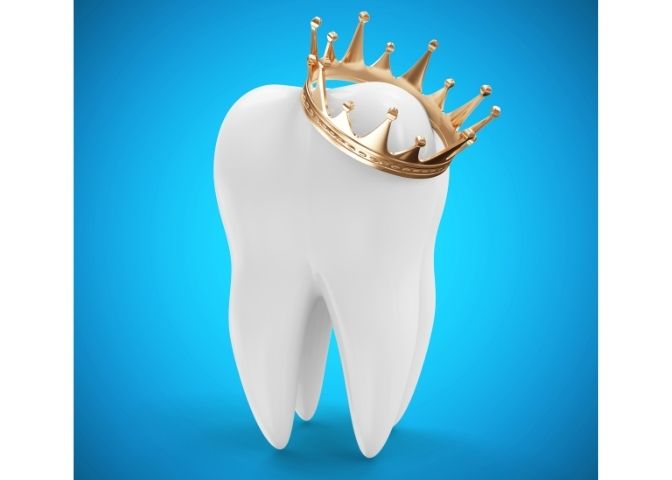What is the difference between these dental two solutions? There is none. They are two different terms for the same thing. Adding to the mix is the term, veneers. Some one may have mentioned these terms along the way, and you are seeking a way to improve your smile as well as your eating ability. We will explain more about why a crown or veneer might give you a smile to be proud of. Crowns can cover, protect and restore the shape of the tooth, where a filling may not solve the problem.
Here at Pearlee Dental Clinic in Ottawa, we want you to know about these different terms and of what the crown is composed as well as how it is used. We hope you will learn more as to whether it might be the right solution for you.
Veneers Are Somewhat Different
The difference between a veneer and a crown is that the veneer only covers the front of a tooth, while the crown covers the whole tooth. More of the tooth is left intact; however, the tooth needs enough enamel for the veneer to be able to securely bond to it.
When Are Dental Crowns Used?
Teeth that are damaged, according to the Canadian Dental Association, may be restored in shape and appearance. In the event that you have had a root canal, a crown may be used. Broken teeth as well as large filling may call for a crown.
As a cap, the crown may cover a damaged tooth. Discoloration of a tooth might also be the reason for considering a crown. The end result will appear to match your natural teeth. Some crowns are used mostly for cosmetic reasons.
Other reasons for the use of a crown include the need to anchor a dental bridge in place. A cap or crown is also be used to cover a dental implant. Teeth that have been treated with the root canal procedure may also get a dental crown.
Who Does the Fitting For a Dental Crown?
A regular dentist may do the procedure. In addition, a dentist who is a prosthodontist may do it; this is someone who has completed a university post-graduate program in prosthodontics, as their specialty. The specialty involves replacing natural teeth with a substitute that is artificial.
Saving Chipped and Cracked Teeth
A crown will protect a tooth that is cracked and weakened. It will keep the tooth from breaking. A tooth that is severely worn down or broken can be restored with a dental crown.
A tooth that has a large filling that takes up most of it may benefit from a crown to cover it.
Some of the Types of Crown Materials
There are different types of crowns; they may be made from a variety of materials. Included are the following:
- Metal crowns
- Composite Crowns
- Porcelain
- Porcelain fused to metal
Metal – the material used is gold. Teeth caps of gold last a long time; however, they are unsightly when used for the front teeth. A metal crown may also be a good choice for a molar that is out-of-sight. Other metals used for teeth include palladium, chromium and nickel.
Composite – with a natural look, these crowns do not chip easily. They wear down a bit more than porcelain, but they may be less expensive than the other types.
Porcelain – this provides the best color matching that looks natural. For those who have metal allergies, this is a good choice. They are not as good a choice for strength as porcelain fused to metal, however.
Porcelain fused to metal – with an ability to be matched to the surrounding teeth, porcelain fused with metal may have a natural look. However, in some cases the metal may show through the porcelain.
Technology and Time
Normally, impressions are first taken, after the tooth has been filed down. The impressions are then sent out to a lab, where the crown is manufactured. The crown comes back, having been made from restorative materials, such as are used for fillings.
A temporary crown covers the filed-down tooth to protect it; it may be somewhat different than the final crown. The final crown comes back; it is checked and then cemented in place.
One of the technologies used is CEREC® technology. Crowns may be prepared in a matter of minutes, meaning that the patient only needs one appointment for a crown. With this innovative CEREC® technology, measurements are taken and the crown is then produced right in the office. The dentist checks the fit on that visit. One visit is involved, rather than the several visits needed for the making of the traditional crown.
Computer-aided technology allows the tooth to be scanned after decay is removed. A digital picture is made and then sent to an in-office machine to be carved out of a ceramic block. It is ready in less than 15 minutes. The dentist then cements it in place, as with a traditional crown.
How Long May a Crown Last?
Dental crowns usually last from five to 15 years. It will depend on your eating and chewing habits. Hygiene and wear-and-tear all affect how long the dental crown will last. Habits like clenching or grinding your teeth, biting fingernails, using teeth to open bottles and packages and crunching on ice will all have an effect on the durability of your crown.
Find Out More
Find dental crowns and caps in Ottawa in Merivale with our skilled prosthodontics dentists. With our digital technology for the making of the crown, we offer the latest and less time-consuming way to fit a custom-designed crown.
Our holistic Riverside South dental clinic is easy to get to. If you have been thinking of making your smile better through the application of a crown, schedule an appointment to learn more about how our technology can help you. Contact us to get started with a dental crown to improve your smile and make eating easier.



